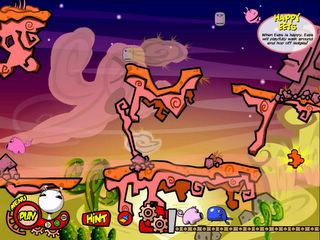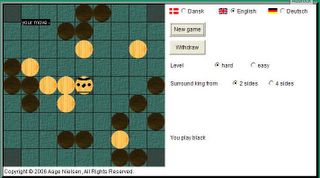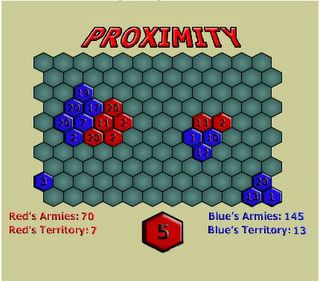Name: Eets: Hunger. It's emotional
Author:
klei entertainmentLicense: commercial
Website:
http://www.eetsgame.com/news/index.phpThis week's game, Eets, has gotten some great reviews. Here are a few:
Game Tunnel,
Jay is Games, and
Gamespot. These are well respected game reviewers. Far more respected and experienced than I am. So, why don't I love Eets just as much as they do? Sure, it is a fun and cute puzzle game. Actually, it may be too cute, but that is a matter of personal taste. I enjoyed playing it. I would suggest you go buy it (well... see my DRM rant below) and play it, or at least give the demo a spin. However, in my opinion, it does not deserve all the raves it is getting.
I was bothered by this difference of opinion for a long time, but eventually I figured it out. The reason why I do not care for Eets as much as many other reviewers is that I am not in its target audience. Eet is aimed at the casual gamer. They are going for a wider audience. This is apparent in the early levels which are a breeze. I was able to get through about half of the levels within the 60 minute demo period. This is not to say that Eets is always easy. Some of the later levels are tricky, but never a deep challenge. Eets was
originally designed for handhelds such as the PSP. The small size limits the scope of the levels and is probably responsible to some extent for easier difficulty.
Now for a one paragraph rant on the term "casual". Many people, even people who should know better, lump all puzzle/logic games into the "casual game" category. There is nothing casual or easy about the games which I enjoy and promote in this blog. Most are quite difficult. The number of gamers in the world capable of finishing
Deadly Rooms of Death is significantly smaller than the number who can beat
Half-Life 2. However, for some reason, many gaming websites put DRoD in the same bin as all of those
Bejeweled clones. It is damn annoying.
I am going to try to put a positive spin on Eets. It is a stepping stone game. After new gamers finish off Eets, they can start to explore the world of hardcore puzzle and logic games. To this end, I think Eets is great. Also, the popularity of Eets shows that there is pent up demand for puzzle games. People are willing to pay real money for a good puzzle game. Maybe, the game developers will take notice.
Before I go on, I need to mention a troubling aspect of Eets. When you purchase Eets, you do not get ownership of a copy of the game. Instead you receive the right to activate five copies of the game. This is very similar to purchasing songs using iTunes. The difference here is that there is no mention of this restriction until after you have sent them your money. The following sentence is from the email they sent me after I purchased the game.
In the event of a license loss, a change in your computer's configuration or if you wish to install the software on additional computers, you will have to RENEW your license by providing us with your: ACTIVATION CODE:
What does "a change in your computer's configuration" mean? This is scary. Depending on your personality, this is either par for the course in the new
DRM world, a deceptive business practice, or plain illegal. I understand that piracy is a problem, but they should have been up front about this policy. If I had known about this restriction, I probably would not have purchased the game. But, I did purchase it, so on with the review.
Hold on, one more mini-rant. I am really troubled that none of the supposedly reputable reviews listed above even mention this activation restriction. Note to game reviewers: your duty is to us game players not the game makers. This means that you should tell us about things like Eets' activation policy. It also means telling us about copy protection crap like
Starforce (which Eets does not contain). I would also like to know if a game requires administrator privilege in order to install and/or play (which Eets does not). Putting these sort of facts in your reviews will not make game developers happy, and they may stop sending you free games to review. But if you have any integrity, this is what you need to do.
Alright, I guess I should describe the game. I will be brief as you probably have already read some of those other reviews. Most of them say Eets is a
The Incredible Machine (TIM) style game. I would actually say
Incredible Toon Machine is more like it. You have to guide Eets, the guy with the big circular head, to his goal, the puzzle piece. Each level comes with some items to place on the board. There is a wide variety of objects to place. The whale for example sucks up nearby objects and spits them out. The cookie shots out chocolate chips. The pig emits exploding piglets when touched. There are many more. Each comes with a nice cartoonish animation. Holding the mouse over any item brings up a description of that item and its actions and effects.

Once you think you have the items placed correctly, hit play. But, unlike most TIM games, hitting play does not leave you an observer. You still have to direct the action with some timely mouse clicks somewhat in the style of
Lemmings. In order to get the whale to suck up and spit out Eets, you need to click on the whale as Eets walks by. You have to pay attention, but the timing is not critical. There is usually a fairly wide window in which a click will work.
The unique feature in the game is that Eets has three different moods: angry, happy, and scared. The main effect of Eet's mood is his action at an edge of a cliff: jump far, jump a little, or turn around. There are a variety of ways to change Eets mood. The primary way is to place special marshmallows for Eets to eat. Thus, the name of the game. Planning these mood transitions is the heart of the game.
Within the game, there are seven puzzle areas. Each area introduces some new items with a few tutorial levels. Then there are roughly ten levels which can be played in any order. To move on to the next area, you only need to complete about half of levels. Thank you, thank you, thank you for this level access model. After completing all these levels, you can try the
fan-made levels. There is more than enough to keep you busy. Some of these are really hard and do require some careful timing.
One nice feature of Eats is the trophy room. When complete certain tasks such as solving a level without using all of the items, you get a trophy. Another trophy is given out when you complete all of the levels. One trophy is for "doing something special." I am not sure what that is. There are ten trophies in all. I have only gotten five of them. Maybe this game is harder than I thought.
Many TIM-like games suffer from a pixel-level accuracy problem. To solve a level, an item might have to place just right. If the item is off by even a couple of pixels, it does not work. Somehow, Eets avoids this. I am not sure how exactly, but I never had to place something just so to solve a level.
The graphics and sound are top notch. Eets is very professionally done game. It is a bit cutesy at time for my taste, but I think I am in the minority on this point. I wish you could turn off the background at times as you can in TIM.






